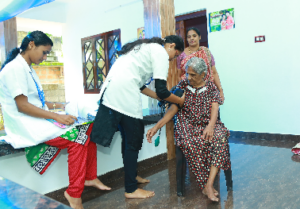Kerala: An Exemplary Story In Palliative Care
Context:
Kerala demonstrates how several social groups came together to build a care infrastructure despite differences in gender, caste, religion, and class. For patients who are poor and ill, palliative care organisations provide weekly home visits by a nurse and a volunteer team. When necessary, they offer free prescription drugs and doctor appointments. The community organisation offers “total care” in various ways.
Points to Ponder:
- The World Health Organisation (WHO) recognises palliative care as a strategy for enhancing the quality of life for people and families dealing with terminal illnesses such as cancer, chronic obstructive pulmonary disease, and cardiovascular disorders.
- Significant Health-Related Pain: These disorders are referred to as substantial health-related suffering that necessitates both medical intervention and physical, social, spiritual, and emotional support by the 2018 Lancet Commission on palliative care and pain reduction.
- India’s Context: India is a middle-income nation with an ageing population and a rising burden of non-communicable diseases. However, it is ill-prepared to deal with widespread, serious health-related suffering because only 4% of the population, mostly in larger cities, is covered by palliative care.
- Model of Palliative Care in Kerala: At the Government Medical College in Kozhikode, Kerala, Drs. M.R. Rajagopal and Suresh Kumar established a pain management clinic for cancer patients who were near death in 1993. Over time, this developed into a network of over 400 community palliative care organisations operated by nurses and volunteers throughout Kerala.
- Infrastructure for Inclusive Care: Kerala’s palliative care model covers diseases like spinal injuries, HIV/AIDS, and geriatric illnesses in addition to terminal cancer. Volunteers from various social groups provide support and are aware of the social pain endured by families dealing with such circumstances.
- Community Ownership: Home-based “total care” that includes medical, social, financial, bereavement, and rehabilitative assistance for patients and families was offered as part of the community’s adoption of palliative care.
- Government Involvement: Recognising the need for governmental assistance, community organisers’ Pariraksha project eventually led to the Left Democratic Front government’s introduction of a palliative care policy in 2008. All 14 districts now have access to primary, community, and tertiary palliative care services.
- The Palliative Care Network in Kerala: Kerala has over 841 of India’s 908 palliative care facilities, making it one of the biggest networks in the world.
- Broader Impact and Innovations: Kerala’s model for palliative care has spawned initiatives for community mental health, the use of support networks during natural disasters (like the 2018 floods), and the incorporation of palliative care into the administration’s response to the COVID-19 pandemic.
- Accessibility and affordability issues: Only 14% of patients who need palliative care do so globally, underlining the inaccessibility and high cost of hospitals and hospices. However, more than 60% of patients are covered by Kerala’s community model.
- Training and education: For doctors, nurses, and volunteers, the Institute of Palliative Medicine in Kozhikode and Pallium India in Thiruvananthapuram both offer community-based training programmes.
- Integration of Palliative Care into Public Health Systems: Kerala’s palliative care model disproves the idea that building public health infrastructure in India is impossible and shows the possibilities for such integration.
- The success of the community model in Kerala has led to a “crowding-in effect” where commercial healthcare providers are forced to give higher quality services than public and community organisations in order to draw in patients.
- Community Solidarities: Kerala’s community palliative care organisations emphasise the significance of solidarity across differences by demonstrating how people can work together to build care infrastructure despite differences in religion, caste, and gender.





